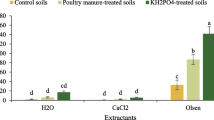Summary
An incubation experiment was performed to determine the influence of the fungicides Benomyl, Captan and Thiram on CaCl2-extractable P. Small, but statistically significant increases occurred in treated soils over the incubation period, to reach maxima 20 days after treatment. Insoluble phosphate (CaH4 (PO4)2) was then added to determine the influence of fungicide treatment on phosphate solubilization. With phosphate additions of less than 100 μg/g of soil, less P was extracted from soils treated with 100 μg of the fungicides/g of soil than from untreated soils. At 200 μg/Pg soil, however, increases in phosphate solubilization occurred. Numbers of both bacteria and fungi capable of solubilizing insoluble phosphate increased in treated soils but no evidence was found for an increase in water soluble organic acids. The results suggest that fungicide treatment selectively increased the proportion of micro-organisms capable of solubilizing both native and added insolube phosphate. re]19760713
Similar content being viewed by others
References
Agnihotri, V. P., Solubilization of insoluble phosphates by some soil fungi isolated from nursery seedbeds. Can. J. Microbiol. 16, 877–880 (1970).
Alexander, M., Introduction to Soil Microbiology. John Wiley, New York (1961).
Berthelin, J., Kogblevi and Dommerques, Y., Microbial weathering of a brown forest soil: influence of partial sterilization. Soil Biol. Biochem. 6, 393–399 (1974).
Cawse, P. A., Effects of low substerilizing doses of gamma irradiation on C, N and P in fresh soils. J. Sci. Food. Agric. 18, 388–391 (1967).
Chhonkar, P. K. and Subba-Rao, N. S., Phosphate solubilization by fungi associated with legume root nodules. Can. J. Microbiol. 13, 749–753 (1967).
Eno, C. F. and Popenoe, H., The effect of gamma radiation on the availability of N and P on soils. Soil Sci. Soc. Am. Proc. 27, 299–301 (1963).
Greaves, M. P. snd Webley, D. M., A study of the breakdown of organic phosphates by micro-organisms from the root region of certain pasture grasses. J. Appl. Bacteriol. 28, 454–465 (1965).
Katznelson, H. E., Peterson, E. A. and Rouatt, J. W., Phosphate-dissolving micro-organisms on seed and in the root zone of plants. Can. J. Bot. 40, 1181–1186 (1962).
Raghu, K. and Macrae, I. C., Occurrence of phosphate dissolving micro-organisms in the rhizosphere of rice plants and in submerged soils. J. Appl. Bacteriol. 29, 582–586 (1966).
Schnitzer, M., Alkaline cupric oxide oxidation of a methylated fulvic acid. Soil Biol. Biochem. 6, 1–7 (1974).
Stevenson, F. J., Organic Acids in Soil.In Soil Biochemistry Vol. 1 (A. D.McLaren and G. H.Peterson, Eds) pp 119–146, Marcel Dekker, New York (1967).
Skipper, H. D. and Westerman, D. T., Comparative effects of propylene oxide, sodium azide and autoclaving on selected soil properties. Soil Biol. Biochem. 5, 409–414 (1973).
Smith, M. S. and Weeraratna, C. S., The influence of some biologically active compounds on microbial activity and on the availability of plant nutrients in soils. Pestic. Sci. 5, 721–729 (1974).
Sowden, F. J., Effects of silica on automated methods for the determination of phosphate. Can. J. Soil Sci. 52, 237–243 (1971).
Sperber, J. I., Solution of meneral phosphates by soil bacteria. Nature London 180, 994–995 (1957).
Wainwright, M. and Pugh, G. J. F., The effect of three fungicides on nitrification and ammonification in soil. Soil Biol. Biochem. 5, 577–584 (1973).
Wainwright, M. and Pugh, G. J. F., The effects of fungicides on certain chemical and microbial properties of soils. Soil Biol. Biochem. 6, 263–267 (1974).
Wainwright, M. and Pugh, G. J. F., Effect of fungicides on numbers of micro-organisms and frequency of cellulolytic fungi in soil. Plant and Soil 43, 561–572 (1975).
Warren, C. G., Hale, H. and Duich, J. M., Influence of benzimidazole fungicides on growth and foliar accumulation ofAgrostic palustria Huds andPoa pratensis L. Comm. Soil Sci. Plant Nutr. 5, 413–427 (1974).
Author information
Authors and Affiliations
Rights and permissions
About this article
Cite this article
Wainwright, M., Sowden, F.J. Influence of fungicide treatment on CaCl2-extractable phosphorus and phosphate-solubilizing micro-organisms in soil. Plant Soil 48, 335–345 (1977). https://doi.org/10.1007/BF02187245
Received:
Issue Date:
DOI: https://doi.org/10.1007/BF02187245




